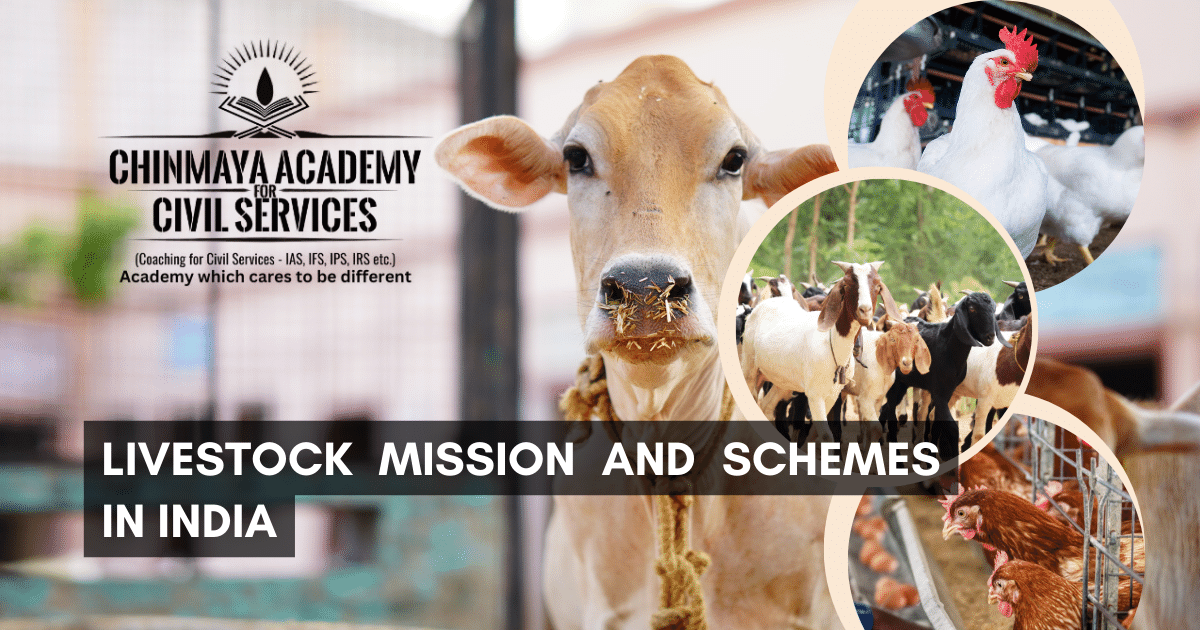 Livestock refers to the animals domesticated and raised in an agricultural set-up to procure products for consumption (meat, milk, wool, egg) and labour to supplement the farmer’s income.
Livestock refers to the animals domesticated and raised in an agricultural set-up to procure products for consumption (meat, milk, wool, egg) and labour to supplement the farmer’s income.
The livestock sector contributes 4.11% to India’s GDP and 25.6% of total agriculture GDP. It also provides employment to about 8.8% of the population in India, two-thirds of whom belong to rural community.
Need for robust livestock sector
- Backbone of the rural livelihood
- Source of reliable income
- Source of upward economic mobility for the poorest
- Shows great export potential along with consistent growth
Schemes
- This scheme encompasses breed improvement and entrepreneurial development of poultry, sheep, goat and piggery.
- The scheme is subdivided into three sub missions
- Sub-Mission on Breed Development of Livestock & Poultry
- Sub-Mission on Feed and Fodder development
- Sub-Mission on Extension and Innovation
-
- Launched in December 2014
- It is presently subsumed under the umbrella scheme of Rashtriya Pashudhan Vikas Yojana/ National Livestock Mission
- Aimed at development and conservation of indigenous bovine breeds to enhance milk production and productivity of bovines
- The scheme also encourages use of high genetic merit bulls for breeding purposes.
- National Kamdhenu Breeding Centre: Two centres one each in northern and southern region has been set up as repository of indigenous breeds.
National Digital Livestock Mission (NDLM)
- To create a ‘farmer-centric system’ with seamless and integrated access to services and information
- Build mechanism for Direct Benefit Transfer
- Create ‘connected livestock market for India’ through improved participation of private sector
- Promote linkage between research and development systems and their implementation on field
- Better align the various national and state programmes
National Mission on Bovine Productivity
- Launched by the Ministry of Agriculture and Farmers Welfare
- Aimed at enhancing milk production and productivity
The Scheme consists of
-
- Pashu Sanjivni– Identification of animals in milk using UID, issuing them with health cards and uploading data on INAPH data base.
-
- Advance Reproductive Technique – Sex sorted semen production facility and 50 Embryo Transfer Technology Labs with IVF facilities are being created in the country
-
- E-Pashu Haat Portal – The portal connects farmers with breeders forming an e-market for livestock germplasm and related services.
-
- National Bovine Genomic Centre for Indigenous Breeds – Established for enhancing milk production and productivity through genomic selection among indigenous breeds.
National Artificial Insemination Programme
- Launched by Madhya Pradesh government, the programme is implemented along with Department of Animal Husbandry, Dairying and Fisheries and National Dairy Development Board.
- Focuses on the use of quality semen and improved scientific techniques for better reproductive performance.
- Artificial insemination technicians will be trained at the district level and services will be rendered to the farmers.
- The programme also aims to reduce the cost of artificial insemination for the farmers.
National Animal Disease Control Programme
- Launched in 2019
- Aims to control and eradicate Foot & Mouth Disease (FMD) and Brucellosis amongst livestock in the country
Livestock Health and Disease Control
The scheme aims to improve animal health through
-
- Various prophylactic vaccination programmes.
- Capacity building.
- Disease Surveillance.
- Strengthening of Veterinary Infrastructure.
The scheme also envisions
-
- To eradicate PPR (Peste des Petits Ruminants) by 2030 by vaccinating all Gheep and Goats.
- To control Classical Swine Fever (CSF) by vaccinating the entire Pig population.
- To provide veterinary services at the farmers’ doorstep through Mobile Veterinary Units (MVUs).
Animal Husbandry Infrastructure Development Fund
- Set up under Atma Nirbhar Bharat Abhiyan stimulus package to incentivize investment in dairy processing, meat processing and animal feed plants.
- Aims to increase milk and meat processing capacity and product diversification by
- Providing greater access to organized market
- Increased price realization for the producer
- Increase availability of quality milk and meat products for the domestic consumer
- Increase the export contribution of the sector
- Fulfills the requirement of protein enriched quality food for the growing population of the country
Livestock Census and Integrated Sample Survey (LC & ISS)
- The scheme is being implemented by the Department of Animal Husbandry and Dairying through State Animal Husbandry Departments.
- Livestock Census: a complete count of the livestock and poultry conducted every five years.
- Integrated Sample Survey : Quantity of four major livestock products namely Milk, Egg, Meat and Wool is estimated based on the annual sample survey. This is used to measure the contribution of livestock sector and its products in the total economy.
Issues faced
- National and state programmes are more focused on largescale producers.
- Limited participation of Private Sector.
- Inadequate access to Markets.
- Limited identification of Livestock Animals and their Subsequent Insurance coverage.
- Limited knowledge or Empowerment to seek Services from the Government
 Chinmaya IAS Academy – Current Affairs Chinmaya IAS Academy – Current Affairs
Chinmaya IAS Academy – Current Affairs Chinmaya IAS Academy – Current Affairs
